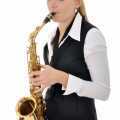Voice classification is both the science and art of determining what voice type an individual singer is. Every singers voice is completely unique, but singers are generally categorized as either soprano, mezzo-soprano, alto, tenor, baritone, or bass, depending on their range. There are other, more highly specialized voice types (such as a male countertenor), but this article will focus only on the main, most common types.
When beginning voice lessons, your instructor will often start with an assessment of your voice type, which is normally determined by the natural range and tone of your voice. After your instructor has determined your present voice type, he or she will begin to recommend which genres of music might suit your voice, or which repertoire would be compatible to your voice in its current state. The progression of your voice can change over time, so just because you may be “labeled” as a soprano or alto, does not mean that you will be that voice type forever.
Just as it is extremely common for young male singers to start as a “boy soprano”, and then change to a tenor or baritone when their voice matures- it is also extremely common for young female singers to change between Alto (or Mezzo-Soprano) and High Soprano. The longer that you study voice and learn the intricacies of your unique instrument, you will learn that your voice type is not always set in stone. This is why it is important to listen to your teacher, for he or she can provide you all the guidance and advice you need for developing and improving your voice to reach its highest potential!
Most common Voice Types:
Soprano: The highest female voice. The range of a well-trained soprano is normally middle C, to High C (C6). The highest of the soprano voices, classified as high soprano (or coloratura soprano) can often sing in their upper extension to a high F above high C (F6). This voice type can have extremes in timbre, from possessing a “light, airy, angelic quality”, to a loud, brassy and piercing sound, depending on different musical styles and the type of voice needed for that style.
Notable Sopranos:
- Renee Fleming
- Julie Andrews
- Mariah Carey
- Celine Dion
- Bjork
Mezzo (or Alto): also known as “middle voice”, this is the most common voice type for females. Typical range is from A3 (below middle C) to High A (A5). The timbre of this voice often possesses a “warmer, more solid and comforting quality” and is extremely well suited for the genres of Jazz and Gospel music, which require a more mature and nuanced sound for expression.
Notable Mezzos:
- Cecilia Bartoli
- Joyce DiDonato
- Aretha Franklin
- Edith Piaf
- Mary J. Blige
Tenor: the highest male voice. The typical tenor voice has a range between the C one octave below middle C, to the C one octave above middle C (C5). The qualities of the tenor voice can range from “sweet and demure”- common for romantic songs, to loud and belting, which is often used in pop music.
Notable Tenors:
- Matt Bellamy
- Andrea Bocelli
- Luciano Pavarotti
- Justin Timberlake
- Elton John
Baritone: a male voice whose range lies between the Tenor and Bass ranges. The range for a baritone is usually the second G below middle C to the G above middle C, or (G2-G4). In operatic music this range can be extended on either end. Baritones commonly have a deeper sound than a tenor, but are lacking in the depth and gruff earthy quality of a true bass.
Notable Baritones:
- Dietrich Fischer-Dieskau
- Thomas Hampson
- Michael Buble
- Elvis Presley
- Nat King Cole
Bass: the lowest male voice, the lowest range of all the voices. The typical bass range lies between the second E below middle C, to the E above middle C (E4), although the lower extremes of this voice can reach the low C 2 octaves below middle C (C2).
Notable Basses:
- Samuel Ramey
- Kim Borg
- Barry White
- J.D Sumner
- Paul Robeson







